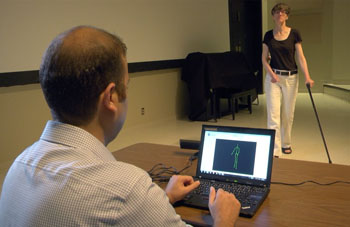Interactive Video Gaming Device Could Aid MS Patients
|
By LabMedica International staff writers Posted on 23 Aug 2016 |

Image: Using Kinect motion-capture camera may improve evaluation of gait pathology in multiple sclerosis patients by increasing objectivity in diagnosis and treatment monitoring (Photo courtesy of the Montreal Neurological Institute & Hospital and McGill University).
A commonly used 3D depth-sensing camera could become a low-cost means of monitoring treatment effectiveness for walking difficulties of patients with gait-impairing diseases such as multiple sclerosis (MS).
The Microsoft “Kinect” motion-detection camera can be hooked up to an Xbox gaming console or a Windows computer for interactive video activities such as tennis and dancing. A team of researchers led by McGill University (Montreal, Quebec, Canada) postdoctoral fellow Farnood Gholami, supervised by Prof. Jozsef Kövecses, collaborated with Daria Trojan, physiatrist at the Montreal Neurological Institute and Hospital, to test whether the Kinect could detect the differences in gait of MS patients compared to healthy individuals. The tool could be useful “to assess treatment effects of certain interventions such as rehabilitation or medication, and to document MS disease progression as reflected by gait deterioration. It may also be useful as a measure in clinical trials,” said Trojan. Additional collaboration was with Behnood Gholami at AreteX Systems Inc. (Hoboken, NJ, USA) and Wassim M. Haddad at Georgia Institute of Technology, (Atlanta, GA, USA).
In current clinical practice, the walking movement of MS patients is usually assessed by their doctors using subjective evaluations that may distort results such that different clinicians may give different evaluations for the same patient. Using computer algorithms that quantify patient walking patterns detected by a camera can reduce potential for human error.
Using Kinect, Dr. Gholami captured the movement of 10 MS patients and 10 members of an age-and-sex-matched control group. The MS patients had previously been assessed for gait abnormalities using the traditional clinician method. Using the data, the team then developed computer algorithms that quantified gait characteristics of MS patients and healthy people. They found that gait characteristics measured with the Kinect camera and analyzed with the developed algorithms were reproducible when assessed at one visit and were different between MS patients and the healthy individuals. Moreover, the gait characteristics of MS patients obtained by the algorithm were correlated with clinical measures of gait. In addition, the algorithms could mathematically define the characteristics of gait in MS patients at different severity levels, accurately determining the level of gait abnormality.
Dr. Gholami became interested in using motion-capture technology for clinical purposes as a PhD student, but the equipment he was using at the time was very expensive, difficult to use, and non-portable, making widespread clinical use prohibitive. Kinect is an inexpensive tool that appears to be accurate enough to do the job. “This tool may help the clinician provide a better diagnosis of gait pathology, and may be used to observe if a prescribed medication has been effective on the gait of the patient or not,” he said, “Our developed framework can likely be used for other diseases causing gait abnormalities as well, for instance Parkinson’s disease.” The next step is to conduct a study with a larger group of MS patients, including evaluation in a gait laboratory, using a newer version of the Kinect device to improve accuracy.
The study, by Gholami F et al, was published July 21, 2016, in the IEEE Journal of Biomedical and Health Informatics.
Related Links:
McGill University
The Microsoft “Kinect” motion-detection camera can be hooked up to an Xbox gaming console or a Windows computer for interactive video activities such as tennis and dancing. A team of researchers led by McGill University (Montreal, Quebec, Canada) postdoctoral fellow Farnood Gholami, supervised by Prof. Jozsef Kövecses, collaborated with Daria Trojan, physiatrist at the Montreal Neurological Institute and Hospital, to test whether the Kinect could detect the differences in gait of MS patients compared to healthy individuals. The tool could be useful “to assess treatment effects of certain interventions such as rehabilitation or medication, and to document MS disease progression as reflected by gait deterioration. It may also be useful as a measure in clinical trials,” said Trojan. Additional collaboration was with Behnood Gholami at AreteX Systems Inc. (Hoboken, NJ, USA) and Wassim M. Haddad at Georgia Institute of Technology, (Atlanta, GA, USA).
In current clinical practice, the walking movement of MS patients is usually assessed by their doctors using subjective evaluations that may distort results such that different clinicians may give different evaluations for the same patient. Using computer algorithms that quantify patient walking patterns detected by a camera can reduce potential for human error.
Using Kinect, Dr. Gholami captured the movement of 10 MS patients and 10 members of an age-and-sex-matched control group. The MS patients had previously been assessed for gait abnormalities using the traditional clinician method. Using the data, the team then developed computer algorithms that quantified gait characteristics of MS patients and healthy people. They found that gait characteristics measured with the Kinect camera and analyzed with the developed algorithms were reproducible when assessed at one visit and were different between MS patients and the healthy individuals. Moreover, the gait characteristics of MS patients obtained by the algorithm were correlated with clinical measures of gait. In addition, the algorithms could mathematically define the characteristics of gait in MS patients at different severity levels, accurately determining the level of gait abnormality.
Dr. Gholami became interested in using motion-capture technology for clinical purposes as a PhD student, but the equipment he was using at the time was very expensive, difficult to use, and non-portable, making widespread clinical use prohibitive. Kinect is an inexpensive tool that appears to be accurate enough to do the job. “This tool may help the clinician provide a better diagnosis of gait pathology, and may be used to observe if a prescribed medication has been effective on the gait of the patient or not,” he said, “Our developed framework can likely be used for other diseases causing gait abnormalities as well, for instance Parkinson’s disease.” The next step is to conduct a study with a larger group of MS patients, including evaluation in a gait laboratory, using a newer version of the Kinect device to improve accuracy.
The study, by Gholami F et al, was published July 21, 2016, in the IEEE Journal of Biomedical and Health Informatics.
Related Links:
McGill University
Latest Technology News
- Coral-Inspired Capsule Samples Hidden Bacteria from Small Intestine
- Rapid Diagnostic Technology Utilizes Breath Samples to Detect Lower Respiratory Tract Infections
- Graphene-Based Sensor Uses Breath Sample to Identify Diabetes and Prediabetes in Minutes
- Wireless Sweat Patch Could Be Used as Diagnostic Test for Cystic Fibrosis
- New Method Advances AI Reliability with Applications in Medical Diagnostics
- Self-Powered Microneedle Patch Collects Biomarker Samples Without Drawing Blood
- Skin Patch Detects Biomarkers in Interstitial Fluid Without Blood Draws
- Handheld Saliva Test Accurately Detects Breast Cancer
- Cutting-Edge AI Algorithms Enable Early Detection of Prostate Cancer
- New Microfluidic System Enables Early Cancer Diagnosis Using Simple Blood Tests
- AI to Transform Skin Cancer Diagnosis in Remote Areas
Channels
Clinical Chemistry
view channel
Gold Nanoparticles to Improve Accuracy of Ovarian Cancer Diagnosis
Ovarian cancer is considered one of the deadliest cancers, in part because it rarely shows clear symptoms in its early stages, and diagnosis is often complex. Current approaches make it difficult to accurately... Read more
Simultaneous Cell Isolation Technology Improves Cancer Diagnostic Accuracy
Accurate cancer diagnosis remains a challenge, as liquid biopsy techniques often fail to capture the complexity of tumor biology. Traditional systems for isolating circulating tumor cells (CTCs) vary in... Read moreMolecular Diagnostics
view channel
Routine Blood Draws Could Detect Epigenetic Biomarkers for Predicting Cardiovascular Disease Risk
Cardiovascular disease is a leading cause of death worldwide, yet predicting individual risk remains a persistent challenge. Traditional risk factors, while useful, do not fully capture biological changes... Read more
Single Cell RNA Sequencing Could Enable Non-Invasive Blood Disorder Diagnosis
Hematologic disorders are often diagnosed using painful, invasive, and expensive bone marrow aspiration or biopsy procedures. These approaches limit patient compliance and broader utility, leaving a need... Read more
Blood Test Identifies HPV-Associated Head and Neck Cancers 10 Years Before Symptoms
Human papillomavirus (HPV) causes around 70% of head and neck cancers in the United States, and cases are rising each year. Unlike cervical cancers linked to HPV, there is currently no screening test for... Read moreHematology
view channel
Pioneering Model Measures Radiation Exposure in Blood for Precise Cancer Treatments
Scientists have long focused on protecting organs near tumors during radiotherapy, but blood — a vital, circulating tissue — has largely been excluded from dose calculations. Each blood cell passing through... Read more
Platelets Could Improve Early and Minimally Invasive Detection of Cancer
Platelets are widely recognized for their role in blood clotting and scab formation, but they also play a crucial role in immune defense by detecting pathogens and recruiting immune cells.... Read more
Portable and Disposable Device Obtains Platelet-Rich Plasma Without Complex Equipment
Platelet-rich plasma (PRP) plays a crucial role in regenerative medicine due to its ability to accelerate healing and repair tissue. However, obtaining PRP traditionally requires expensive centrifugation... Read moreImmunology
view channel
Companion Diagnostic Test Identifies HER2-Ultralow Breast Cancer and Biliary Tract Cancer Patients
Breast cancer is the most common cancer in Europe, with more than 564,000 new cases and 145,000 deaths annually. Metastatic breast cancer is rising in younger populations and remains the leading cause... Read more
Novel Multiplex Assay Supports Diagnosis of Autoimmune Vasculitis
Autoimmune vasculitis and related conditions are difficult to diagnose quickly and accurately, often requiring multiple tests to confirm the presence of specific autoantibodies. Traditional methods can... Read more
Blood Test Predicts Immunotherapy Efficacy in Triple-Negative Breast Cancer
Triple-negative breast cancer (TNBC) is an aggressive subtype lacking targeted therapies, making immunotherapy a promising yet unpredictable option. Current biomarkers such as PD-L1 expression or tumor... Read more
Simple Genetic Testing Could Predict Treatment Success in Multiple Sclerosis Patients
Multiple sclerosis (MS) patients starting therapy often face a choice between interferon beta and glatiramer acetate, two equally established and well-tolerated first-line treatments. Until now, the decision... Read moreMicrobiology
view channel
Microfluidic Platform Assesses Neutrophil Function in Sepsis Patients
Sepsis arises from infection and immune dysregulation, with neutrophils playing a central role in its progression. However, current clinical tools are unable to both isolate these cells and assess their... Read moreNew Diagnostic Method Confirms Sepsis Infections Earlier
Sepsis remains one of the most dangerous medical emergencies, often progressing rapidly and becoming fatal without timely intervention. Each hour of delayed treatment in septic shock reduces patient survival... Read more
New Markers Could Predict Risk of Severe Chlamydia Infection
Chlamydia trachomatis is a common sexually transmitted infection that can cause pelvic inflammatory disease, infertility, and other reproductive complications when it spreads to the upper genital tract.... Read more
Portable Spectroscopy Rapidly and Noninvasively Detects Bacterial Species in Vaginal Fluid
Vaginal health depends on maintaining a balanced microbiome, particularly certain Lactobacillus species. Disruption of this balance, known as dysbiosis, can increase risks of infection, pregnancy complications,... Read morePathology
view channelAccurate Pathological Analysis Improves Treatment Outcomes for Adult Fibrosarcoma
Adult fibrosarcoma is a rare and highly aggressive malignancy that develops in connective tissue and often affects the limbs, trunk, or head and neck region. Diagnosis is complex because tumors can mimic... Read more
Clinicopathologic Study Supports Exclusion of Cervical Serous Carcinoma from WHO Classification
High-grade serous carcinoma is a rare diagnosis in cervical biopsies and can be difficult to distinguish from other tumor types. Cervical serous carcinoma is no longer recognized as a primary cervical... Read moreIndustry
view channel
Werfen and VolitionRx Partner to Advance Diagnostic Testing for Antiphospholipid Syndrome
Antiphospholipid syndrome (APS) is a rare autoimmune disorder that causes the immune system to produce abnormal antibodies, making the blood “stickier” than normal. This condition increases the risk of... Read more


















